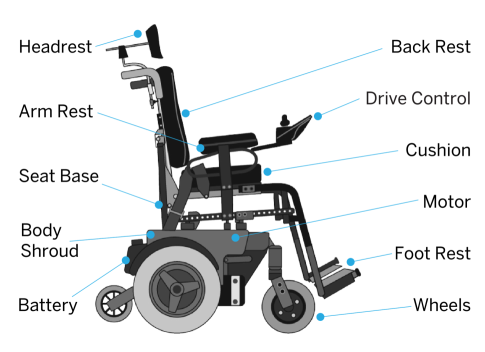Powered Wheelchair
Powered wheelchairs are mobility devices used by persons with disabilities who operate the chair with an electronic device. They are typically bigger and heavier than manual wheelchairs.
Every powered wheelchair is unique, and each can be outfitted with a variety of frames and configurations. A powered wheelchair is often expensive and customized to fit the particular needs of its operator.
Due to their size and potential issues concerning batteries, powered wheelchairs are not required to be transported in the cabin. However, they must be stowed in the baggage compartment consistent with safety, security, and hazardous materials rules.
Powered wheelchairs are highly modifiable devices designed to best meet the specific needs of an individual.

| Headrest | Some wheelchairs are equipped with a headrest to support the individual’s head while the wheelchair is in motion and as the chair changes tilt to perform tasks related to an individual’s disability. |
| Arm Rest | Some armrests can be adjusted vertically to allow the user to transfer out of their chair into another. |
| Seat Base | The seat base is usually fixed to the backrest. The seat base may have a powered tilt option or a manual option to set it in place. |
| Body Shroud | This is the plastic covering that sits underneath the seat base and covers up the batteries and motor that run the powered wheelchair. This may have to be removed in order to reach the batteries. |
| Battery | Powered wheelchairs usually have two batteries that are generally located under the seat base. In order to reach them, the seat base may need to be removed. |
| Back Rest | The backrest on a powered wheelchair can be manually adjustable or power-adjustable depending on the individual’s capabilities. There may be a seatback release lever on one of the sides of the chair. |
| Drive Control | The drive control generally consists of a power button, horn, speed controls, a directional controller (joystick or trackpad), and may include a control to adjust the height and/or tilt of the seat. Drive controls are usually connected to the wheelchair’s battery by a cable that runs from the drive control to the back of the chair and plugs directly into the battery outlet. They are usually located on one of the armrests of the wheelchair. Depending on the individual’s disability, the drive controls can be altered to better accommodate the individual’s disability and may be affixed to the headrest or another part of the chair to allow the operator to use the control in the most convenient or comfortable way. |
| Cushion | Some seat cushions are removable and passengers may want to use them for their seat on the aircraft for a more comfortable flight. |
| Motor | The motor of a powered wheelchair is generally located under the seat base. |
| Foot Rest | Many wheelchairs come with footrests that are foldable or removable by a lever located at the joint of the foot rest or at the point where they attach to the body of the chair. |
| Wheels | Powered wheelchairs generally have two larger wheels that drive the chair and several “caster” wheels for stability. Caster wheels are smaller wheels located at the front or back of the chair. These wheels allow the chair to turn in the desired direction. On most models the two drive wheels will have a manual brake installed next to one or both of the wheels. |
